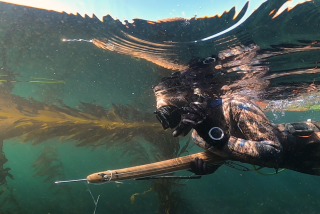Outdoors : ‘Rosebud’ Is Rod, ‘Californian’ Reel : Fishing: Pearlman would like for his lifelong affinity for tackle to culminate in a museum.
- Share via
The Great Depression gripped the country in the summer of 1936, so for a 12-year-old boy Coney Island was a magical place.
“Money was a little scarce, but I could buy a dozen worms for a dime and I would cut ‘em in half and catch a dozen whiting or more,” Ed Pearlman recalled. “Sell off maybe five for a quarter on the boulevard near the pier and have enough to take home and pay for my worms and maybe buy some hooks and stuff.”
A washed-up Babe Ruth had gone from the New York Yankees to the Boston Braves the year before, but that didn’t bother Pearlman. His hero was Captain Henry, who had a small tackle shop and spun tales of sailing around the Horn and knew more about fishing than anybody.
“I never did find out whether Henry was his first or last name or, for that matter, whether he had ever been a captain,” Pearlman said once. “No matter.”
Pearlman was drawn magnetically to a display case of exquisite Edward Vom Hofe reels in Captain Henry’s shop--especially a surf-casting reel that cost $65.
“So majestic. So regal. So unattainable,” he said.
He turned his focus to the used rack for something nearer his means: a split cane surf rod-and-reel combination for $12. The reel was labeled, prophetically, “Californian.” Pearlman offered Captain Henry his life’s savings of $2.50 to put it on layaway.
“Instead, he said, ‘Take the rod and reel now and work next summer in the store to pay off the $12.’ That’s how I got the rod and reel,” Pearlman said.
Pearlman used that rod and reel until World War II, when he left it behind to go off to the Pacific. By the time he returned, his family had moved to California, and nobody knew what had become of the tackle. Over the next 40 years Pearlman would wonder about it every once in a while.
Pearlman settled in Tarzana and started collecting fishing gear in a building beside his home. It’s one of the largest collections of antique and historic tackle in the West.
Pearlman estimated that he has between 1,300 and 1,500 reels, most made of nickel-silver or nickel-plated brass, keeping some in old wooden soda pop cases, others on wall shelves behind glass and the best in glass display cases--including his own Vom Hofes, just as in Captain Henry’s shop. There are about 500 rods of every size and variety, and some 2,500 lures.
None of it replaced that original rod and reel, but Pearlman figures the lot is worth up to $200,000. He enjoys sharing it. Other serious collectors, buyers or sellers are welcome at his home, but should call for appointments: (818) 342-0260.
“This is the ultimate reel that I have, (in terms of being) unique (and) most expensive,” he said, referring to a 16 3/4-pound Vom Hofe the size of a bowling ball. “It weighs so much, you didn’t carry this. You sat in a fighting chair. You’re talking 1,500-pound black marlin. This was the state of the art across all the years when reels were made.”
In 1938, the reel sold for $375. A similar one today would cost about $2,500, but Pearlman won’t be convinced that it would outfish the Vom Hofe.
“There have been some experiments fishing with the old tackle,” he said. “The bass lures are as good or better than the lures they are using today.”
He picked up an old catalog, with wooden and metal lures and other pre-World War II tackle, before plastic and fiberglass took over.
“This book is 1940. The stuff they’re making today will not outfish this stuff, and this stuff is all available. I’m a little bit negative about it, because I think everything now is built with a calculated obsolescence . . . designed so you’ll buy another one next year.”
Pearlman has rods of layered bamboo made in the 1920s, some with line guides on opposite sides to alternate when the rod starts to take a “set.”
“A big thing today is super high-speed reels (with) 6-to-1 gear ratios to bring the lure back that much faster,” he said. “I’ll show you something. Here’s one that’s 9-to-1.”
The reel was made by the Carlton Co. of Rochester, N.Y., in 1903.
“Perfectly good,” Pearlman said.
The first narrow-spool fly reel was made by Orvis in 1874, the first spinning reel by Mulluck in 1890. Pearlman doesn’t have them, but he is convinced they would still catch fish.
Rick Edmisten, a fellow collector who specializes in lures--he has up to 6,000, some worth as much as $20,000 each--said: “There’s really nothing new when it comes to fishing tackle. They just resurrect the old stuff and tell you it’s new.”
An exception is modern monofilament fishing line.
“Better,” Pearlman said. “The old line was either braided silk or braided nylon. It took up more room. The reason that (saltwater) reel is so big was we were using linen line. The diameter was double for the same strength in monofilament.”
He runs off a length of the linen line.
“This is Zane Grey 84-pound test No. 42 . . . 500 yards. In order to put 1,500 yards of this on a reel, you had to have a reel that size. This has more drag in the water, so it’s harder to use this. The rods were heavier and took a little more maintenance. Everything was a little more difficult. It took a little more effort. Everything had to be made to last.”
But was it any better at catching fish?
“No way,” Pearlman said.
Some of the reelmaker’s names were legend: Pflueger, Shakespeare, Meisselbach, Meeks, Talbot. They roll off Pearlman’s tongue like old friends, each with its own history.
“The origin of bait-casting reels as we know them, with gears in them, was (by) a guy by the name of George Snyder,” he said. “This is going back to 1815. He was a watchmaker, and it started a trend. Most of the watchmakers were of German descent, and the reel industry started with that guy and his apprentices, who were Marlin and Meeks and Talbot.
“The best reelmakers in the world were right here in Los Angeles--names I could name that would bring tears to the eyes of a 1930s fisherman. Zane Grey fished with (reels made by) Joe Coxe, who was on 25th Street, and Arthur Kovalovsky, who was in North Hollywood. Here’s a blotter from his original shop in Santa Monica. His son is still alive and one of the finest reelmakers in the world.”
In 1911, Pearlman said, Coxe and his assistants developed the first patented star-drag reel in the basement of a house in East Los Angeles.
“Sportfishing, as we know it today, started right here in Southern California,” Pearlman said. “No question about it. The first (big game) fish caught with a rod and reel was caught off the coast between here and Catalina--we’re talking about 1896--and it was caught by a doctor who formed the Tuna Club.
“The sportfishing industry is only 90 years old. Prior to that, everyone was fishing for food, so they didn’t have fancy equipment. There were the elite and affluent who bought the Vom Hofe reels and all of the good stuff.”
Even after World War II, Pearlman said, “This was the headquarters for fishing reels. A lot of these small companies that were doing aircraft subcontracting went into reelmaking. They had the aluminum, the stainless steel, the engineers, and they had the market for it because everybody was coming home wanting a new fishing rod and reel. This is where it all started.”
Pearlman, now retired, has had diverse careers--first as the owner of four flower shops, later as founder and operator of the Baja 1,000 off-road race. His car still bears NORRA plates, for the National Off-Road Racing Assn.
Now, with Southern California’s fishing history, he has another dream: to be curator of a public fishing museum. There is none of significance west of the Mississippi. All he needs is a backer. Profits would go to conservation.
“There are a lot of collectors and clubs that would work with me free,” he said. “This is for the public.
“It should be out on the end of one of the piers. The state owns Santa Monica Pier or Malibu Pier or Redondo Pier, and they rent it out to hot-dog stands. Almost anybody would walk out to the end of the pier if they knew there was something there to see.”
Interest in fishing has never been higher. TV shows built around people fishing? Believe it.
On Feb. 10-11, Pearlman, Edmisten and about 200 of their fellow collectors will gather in North Hollywood for the annual National Fishing Lure Collectors Club Exchange for the Western United States. The group has 3,000 members nationwide.
“There are more than 60 million fishing licenses a year sold in the United States,” Pearlman said. “Only drivers’ licenses sell more than fishing licenses. That’s a lot of interest.”
Why not a museum? Ed Pearlman’s other dreams have been fulfilled. Six years ago, he got a phone call from the East.
“My aunt, just before she died, called up and said, ‘Ed, I’ve got your father’s fishing pole. It’s in the basement marked, ‘Pearlman.’ ‘ ”
It was the old rod with the Californian reel.
“I said, ‘Aunt Betty, my dad didn’t fish a day in his life. That’s my fishing pole. Put it in a piece of PVC pipe and ship it out here.’ So she did, and I restored it.”
Now, the rod has its own special place over the fireplace. Pearlman’s Rosebud. Every time he looks at it, it’s 1936.
More to Read
Go beyond the scoreboard
Get the latest on L.A.'s teams in the daily Sports Report newsletter.
You may occasionally receive promotional content from the Los Angeles Times.










